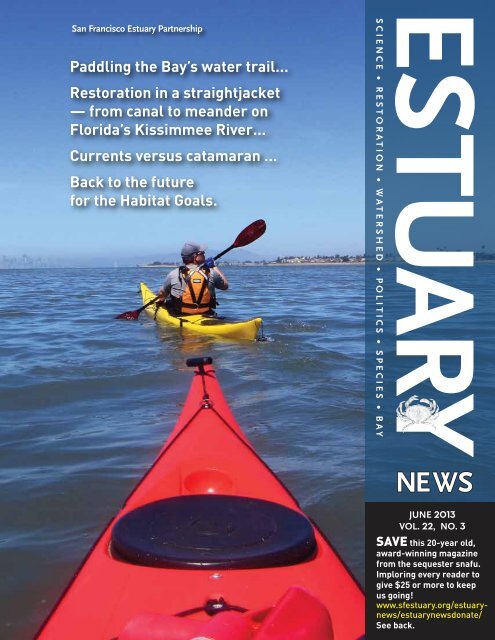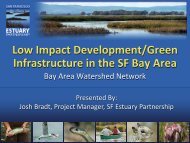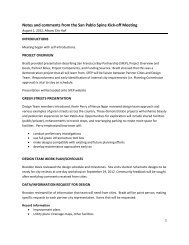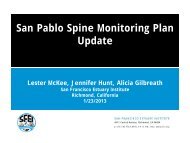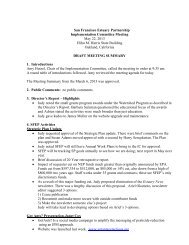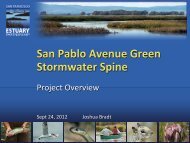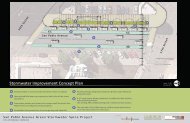Estuary News, June 2013 PDF - San Francisco Estuary Partnership
Estuary News, June 2013 PDF - San Francisco Estuary Partnership
Estuary News, June 2013 PDF - San Francisco Estuary Partnership
Create successful ePaper yourself
Turn your PDF publications into a flip-book with our unique Google optimized e-Paper software.
3H Y D R O L O G YBay versus BoatsIn light of the two recent crashes,one deadly, much has been made ofthe relative safety of the new America’sCup boats on the <strong>San</strong> <strong>Francisco</strong>Bay. Are the $10 million catamarans,known by the class name AC72, simplytoo fast and too light to sail safelyunder any conditions? Or are localconditions responsible?The pattern of surface currentson the Bay is uncommonly complexdue to the narrow opening of theGolden Gate and the varied geologyand bathymetry of the inner Bay, saysUS Geological Survey coastal geologistPatrick Barnard. “It’s never reallyunidirectional if you go across thewest Central Bay,” he said. “There’salways currents going in the oppositedirection” (see graphics).These currents move swiftly — upto 2.5 meters per second at the mouthof the Bay — and change direction ona dime, making it rare to encounter“slack” water. Where opposing currentsconverge, he says, sailors canexpect choppy water and even eddies.All this is compounded by tidal shiftsand the powerful gusty winds blastingthrough the Golden Gate.However, it’s unclear how muchthese conditions impact the AC72,especially when it floats over the wateron massive hydrofoils at speedsof up to double the wind speed. JohnArndt, of the Marin-based sailingmagazine Latitude 38, says theAC72 was designed in part to suit<strong>San</strong> <strong>Francisco</strong> Bay, and that typicalconditions are unlikely to be a safetyfactor for America’s Cup sailors.However, he does acknowledge thatthe complex interaction of surfacecurrents adds to the challenge of therace. ”The current is what makes itinteresting sailing on the Bay; it addsanother level of intrigue,” he says.Local sailing expert Kimball Livingstonagrees that the Bay’s complexcurrents need to be accountedfor, but thinks that their influence onPhoto: Guilain Grenierthe AC72 is limited. “If you’re going40 mph, the tidal component is goingto be a lot less,” he says. “The boatsare so fast that it takes a very largetidal component to override otherfactors.”Ultimately, both suggested thatfinal blame for the two crashes todate may lay with the boats, eitherdue to design shortcomings or structuralflaws. “You’re not supposed tobreak a boat when you have a crash,”Livingston says of the Artemis Racingincident on May 9. “There was somethingelse that went on.” NSScientists can get a sense of flow directions and currents by tracking sediments suspended in the water. These two charts show simulations for aflood tide and the onset of an ebb tide under the Golden Gate Bridge. Note the formation of eddies immediately inside the Golden Gate on the bayside of Pt. Cavallo and Fort Point at flood tide. During the transition from flood to ebb tide (right panel) transport is complicated by the presence ofrock outcrops and deep channels that make up the seabed at the Gate. (White lines and circles show areas where measurements were obtained.)Source: Erikson, L.H., et al, USGS, as submitted for Marine Geology, Special Issue on <strong>San</strong> <strong>Francisco</strong> Bay.
4SNAPSCIENCEWetland Swingers: After sinking 24sediment cores into South Bay marshes,US EPA’s Elizabeth Watson and UCBerkeley’s Roger Bryne suggest thatthe 1800s historic bayland that loomslarge in the region’s collective unconscious(and conscious) goals for wetlandrestoration represents not someancient marsh, but a relatively newthing. Indeed most of these marshesformed rapidly during the recent LittleIce Age, when copious rain and runoffloaded the shoreline with sediment.“We’ve got to stop thinking of our wetlandsas fragile,” says aquatic biologistPeter Baye. “On the contrary, the newevolutionary models of the ecology andgeomorphology of Bay marshes suggestthat rather than maintaining someidealized equilibrium, these wetlandshave been lurching back and forthbetween alternative states of brackishand salt marsh, and through prolongeddroughts and deluges, for thousandsof years. We’re just not used to thinkingof these disruptions as being partof the history of the marshes.” Thisnew research comes on the heels of adecade of paradigm-shifting studies ofthe region’s more ancient ecologicaland climatic history that underscore theneed for adaptive management in thefuture. ARO & PBKrill Bonanza: The seabird colonieson the Farallon Islands may becatching a break this year, thanksto favorable ocean conditions. “Itlooks like there is a lot of upwellingand abundant krill,” says PointBlue Conservation Science biologistRuss Bradley. This has allowed somespecies to get a jump on the breedingseason: “Cassin’s auklets had theirearliest year in a decade. Commonmurres laid the earliest egg everobserved on the islands.” Brandt’scormorants, which experienced highchick mortality in recent years, alsostarted breeding and seem to behaving better luck. Bradley is hedginghis bets: “The question is whether[the krill bonanza] translates to moreschooling forage fishes later in thesummer, and whether species likewestern gulls and Brandt’s cormorantscontinue poor productivity or‘bounce back’ this year.” JEContact rbradley@prbo.orgESTUARYSturgeon Sighted in<strong>San</strong> Joaquin: The <strong>San</strong> Joaquin Rivermay be a badly degraded waterway,but it still feels or smells right towhite sturgeon. As reported in thecurrent Interagency Ecological Program<strong>News</strong>letter, US Fish and Wildlife Servicebiologists have documented forthe first time that these huge archaicfish are spawning in the <strong>San</strong> Joaquin,reinforcing previous anecdotalevidence. Fertilized sturgeon eggswere collected on artificial spawningmats made of furnace filter material.Spawning occurred at one StanislausCounty site in 2011 and four sites in2012. This indicates that white sturgeonuse the river in both wet (2011)and dry (2012) years, not just in highflowyears as previously speculated.It’s hoped that further research in the<strong>San</strong> Joaquin will help improve spawningsuccess and survival of sturgeonhatchlings through habitat restorationand appropriate water management. JEContact zachary_jackson@fws.govCourtesy Aquarium of the BayNo Trends for Mercury inForage Fish: Mercury, one of theBay’s legacy contaminants, was thefocus of a recent SF <strong>Estuary</strong> Institutestudy. Ben Greenfield and colleagueslooked for seasonal and spatial patternsin mercury concentrations inthree species of forage fish: topsmelt,Mississippi silversides, and arrowgoby. All three are food sources forfish-eating birds. The group’s articlein Science of the Total Environment,shows the difficulty of generalizingcontaminant trends across speciesor locations. No consistent regionaltrends were apparent over the sixyears of sampling. Greenfield saysthis was not a surprise: “Mercury ishighly variable over space and time,and it may take decades for longtermtrends to be seen.” Gobies andtopsmelt showed different seasonaltrends, probably related to habitat.The sedentary burrow-dwellinggobies had highest mercury levels inlate summer and early fall, while themore mobile topsmelt peaked in latewinter and early spring. Location wasimportant for silversides: in AlvisoSlough, concentrations increasedNEWSJUNE <strong>2013</strong>over the sampling period. This mayhave been related to lower dissolvedoxygen in the river channel, causingincreased methylmercury production.Since mercury bioaccumulationtrends are specific to site and fishspecies, Greenfield recommends thatwater-quality and restoration managersconsider a site’s managementobjectives in deciding which speciesto monitor. JEContactbengreenfield@berkeley.eduFlame Retardants Falling inFood Web: Polybrominated diphenylethers (PBDEs), chemicals used asflame retardants in furniture, electronics,and other products, were a majorhealth concern for <strong>San</strong> <strong>Francisco</strong> Baywhen alarmingly high concentrationswere reported in local wildlife andhumans in 2002. Since then, the majorUS manufacturer stopped producingtwo of the three PBDE formulations,and state and federal rules restrictedtheir use. The payoff, according to anew draft report by Rebecca Suttonand colleagues at the <strong>San</strong> <strong>Francisco</strong><strong>Estuary</strong> Institute, is a dramatic declinein PBDE levels in the Bay’s food webover the last ten years. Concentrationsfell in mussels and clams, the eggs ofcormorants and terns, and sport fish,where levels were below recently developedhuman health advisory guidelines.The final report will be availablelater this year. JEContact rebeccas@sfei.orgSplittail Surge: Sacramentosplittail, a large California-endemicminnow, had a banner year in theYolo Bypass during the last wet pulse,according to sampling data from theDepartment of Water Resources supportedby the Interagency EcologicalProgram. From October 2010 throughSeptember 2011, 11,295 juvenile splittailwere caught in the researchers’rotary screw trap near the Lisbon Weir,the highest number since monitoringbegan in 1998. The Bypass has beenrecognized as good splittail rearinghabitat. The new peak in water year2011 is attributed to early pulse flowsin winter that brought up spawningadults, followed by a longer-than-usualperiod of floodplain inundation. Thesplittail has undergone a long-termrange contraction and was at one pointlisted as threatened. JEContactjared.frantzich@water.ca.gov
KissimmeeLake OkeechobeeCoastalEvergladesKissimmee River restoration.Courtesy South Florida Water ManagementDistrict.Nearly a decade ago, Lightsey, whonot only breeds cattle but also runshunting trips on his land (Johnny Deppwas one of his clients) became one ofthe first of the region’s landowners toprotect his ranch through conservationeasements.As many have noted, Lightsey, whohas won many awards for his work,sold development rights to his landwhen real estate values in Florida weresky high.“I can’t understand why moreranchers don’t do this,” Lightsey says.“You have to focus on the big picture.You can’t think the whole thing isabout money.”But setting up conservation easementsto fend off development is notenough. Many ranchers are workingwith the Natural Resources ConservationService to do low-tech restorationwork: digging ditches and buildingweirs to trap water. These simple measurescreate wildlife habitat and havethe additional benefit of recharginggroundwater.In these days of scarce governmentfunding, the farm bill has provedessential to Florida’s conservationefforts. Jenny Conner-Nelms, thegovernment relations director for theFlorida Nature Conservancy, has beeninstrumental in developing the strategyof funding restoration through thefarm bill’s wetland reserve program,which has yielded $269 million toprotect 50,000 acres in conservationeasements in northern Florida.“We have been extremely fortunate,”says Conner-Nelms. “Many people don’trealize that the farm bill is the largestamount of money from the federal governmentfor the environment.”When it comes to persuading ranchersto participate, it helps that the actualrestoration is a fairly low-tech affairthat doesn’t require major changes inagricultural practices, according to GregKnecht, Director of Protection at the NatureConservancy’s Tallahassee office.Initially, Knecht says, some rancherswere dubious. But as pastures becamehealthier and the water table rose, theprogram has gained adherents.BIGSCREENColorado RiverStory ParallelsOur OwnAnyone who knows the ins andouts of California’s water wars, andthe lay of the land and water for themuch-managed Sacramento-<strong>San</strong>Joaquin River system, will appreciatethe new movie Watershed. Producedby the Redford Center andKontent Films, the 54-minute filmtakes on the tough task of making“a positive movie about westernwater,” says director Mark Decena.The main premise is the need toget two percent of the flow of themighty Colorado — which flows1,400 miles through seven states,from headwaters in the Rockies allthe way into Mexico — to make itall the way to the river’s delta in theGulf of California. So much of theriver’s water is harnessed that thereis little or nothing left for this driedout delta, once a two million acrewetland.Finding this two percent, it turnsout, is more about the conservationand stewardship ethics of usersupstream than anything else, andthe movie tries to show that. Themovie tells the water story frommultiple points of view at all scales– from the Navajo woman in NewMexico remembering her ancestors’tales of how rain comes from thesky because of a great celestial loveaffair to the water choices made byorganic farmers, city mayors, gasdrillers, fly fishermen, and a LosAngeles family that’s taken to ridingbikes and irrigating their gardenwith water from their showers.When the lights came back up,this viewer was struck by severalthings. Instead of all the tired tradeoffsand non-negotiables of theWestern water wars, I got humorand hope and chutzpah. I enjoyedthe use of artsy animations to gettough science and water developmenthistory across. And while thejumps in the storytelling, as thecamera moves back and forth upand down the watershed, were confusingat first, in the end they succeededin conveying a strong senseof watershed. Namely, how waterconnects landscapes and people.7“The farmers are frustrated sometimes,”says Knecht. “It’s a case of‘first you told us to drain it, now you’retelling us to fill it in?‘ But the reality isthat water is going to drive the future ofeverything that happens in Florida.” SZSouth Florida Water District:www.sfwmd.govFurther Reading: The Swamp, by 2009State of the <strong>Estuary</strong> conference speakerMichael Grunwald; and for thosewith patience and a taste for greatliterature, Killing Mr. Watson by PeterMatthiessen.I was also struck by the parallelsto our own experience with the <strong>San</strong><strong>Francisco</strong> <strong>Estuary</strong>. The stories andsome of the details may be different,but core truths are the same:big rivers harnessed and compartmentalizedso they can water bigag and big cities; and the small butinexorable push back from peoplewho’d like to save the fishing andhabitats and ecology of these greatriver systems. As both California’sand Colorado’s systems face theprospect of a drier climate, lessfresh water runoff, and increasingdemand out West, the solutionsmay prove similar. Every user has toconserve and recycle at every scale.And ever user has to rememberwhat they use affects those downstream,who might be able to reconnectthe dregs of a mighty river withthe ocean, and begin to restore thewasteland of its delta, with just twopercent of flows. Go figure. AROCommunity Screenings Freehttp://watershedmovie.com/
8youthspeaksThe Invader CrabBy Charlotte Witter, Student,<strong>San</strong>ta Clara UniversityI’m a European green crab,so call me LouIf you need to find meI live at Elkhorn SloughI used to live in Europe and Africain the NorthBut invaded the rest of the worldwhen I decided to go forthFirst I travelled to the East Coast andthen to the golden stateI started my journey in the 1800s and I’mstill here to date!They loved me in Europe andcalled me a “native”But now in California they thinkI’m invasiveMy official name is Carcinus maenasJust because I’ve invadeddoesn’t mean that I’m heinousMe and my crab friends are declining,that you are taughtWe personally don’t like thatbecause we like it here a lot!With estuaries, tides, anda deep habitatThe life of the green crab,you really can’t beat that!If you’re looking for the big ones,such like meGo to deep muted tidesand there you will see!Or if you are looking forwhere abundance is highYou can find us at the estuarinewhere we little crabs lieIn the future although my friendsand I will declineCome to the Slough, educate yourself,and take the timeGet to know the species aroundwhere you liveBecause you affect the future and it’syour turn to giveIf you want to help moregrab a map and a kitWe’re all one ecosystemand so it’s definitely worth it!ESTUARYr e c r e a t i o nThe dock is getting smaller andsmaller as I paddle away. I have beenwaiting for this view for a long time.As planner for the <strong>San</strong> <strong>Francisco</strong> BayArea Water Trail I visit many launchsites around the Bay. During theselandside visits I cannot help but stealfurtive glances at the water, wishing Icould put myself in a boat and explorethe waters beyond. And here I am atlast, in a kayak, watching the dock atTidewater recede, and the view of <strong>San</strong>Leandro Bay get bigger.Tidewater Boating Center, the firstsite to be included in the Water Trailnetwork, is owned and managed byEast Bay Regional Parks and locatedat the southern end of the Oakland<strong>Estuary</strong>. The Water Trail is a new,growing, regional trail. It’s not exactlya trail in the literal sense, but a seriesof launch sites around the Bay, likeTidewater, for non-motorized smallboat users. I like to think of it as aweb that you can explore for as littleor as long you like, and go in all differentdirections anchored by thenetwork of launch sites. Today I headtowards Bay Farm Island and theopen bay.As I look out on the water I seethousands of shorebirds. They flyclose together, and like a school offish, a sudden change in directioncauses the flock to change from gold,to white, and back to gold. Duringour paddle we are accompanied bychattering terns flying overhead andNEWSJUNE <strong>2013</strong>Paddling At LastPhoto: Galli Bassoncormorants diving. A group of rowerspasses by, moving quickly in a synchronizeddance.This is a complex landscape. <strong>San</strong>Leandro Bay is nestled betweenresidential communities, shorelineparks, the Bay Trail, and the OaklandAirport. It also provides importanthabitat for migratory and residentbirds, including the endangeredCalifornia clapper rail. Urban and wildmeet here, and the Water Trail usergets to soak it all in — even becomingpart of the scenery.I raft up with my partner to eatlunch. This pause from paddling allowsme to notice movement in theshallow water. I train my eyes on thewater, and soon spot it again. A leopardshark darts by! And then another,and soon a dozen more. They arebeautiful, primal, almost exotic.As I sit watching leopard sharkscruise by our boats, I am impressedby how interesting this landscape is,and by how many ways people canenjoy the shoreline. The <strong>San</strong> <strong>Francisco</strong>skyline and Bay Bridge form astriking backdrop. Nearby is a sandybeach withfamilies enjoyingthemselves.Bikersand joggersare using theBay Trail.Backonshore Iam gratefulfor the dock,parking lot,restrooms,and all thefeatures thatallow me toget on thewater safelyand comfortably.But nexttime I go ona site visit, Iwill not be able to resist daydreamingabout being on the water. GBWater Trail: www.sfbaywatertrail.org
9c l i m a t eCap & Trade Roadshow, Six Months LaterIn the last six months, Californiahas held three very special auctions,and the items in question are muchharder to put your finger on than thegilt rim of a tea cup. In this auction,the objects are less tangible — the socalled greenhouse gases, or GHGs,known to warm earth’s atmosphere— but more likely to influence thecourse of human history than anymahogany credenza or dueling pistol.Whenit passedthe CaliforniaGlobalWarmingSolutionsAct in 2006,the goldenstate firmlyembracedthe singularroleof leading our frustratingly reluctantnation on climate change action. AB32 set the goal of returning the stateto 1990 emission levels by 2020 andlaunched a dozen different initiativesto get there, from renewable energyinvestments to a low-carbon fuel standard.It also created the nation’s firsteconomy-wide cap and trade programfor emissions.“Cap and trade covers 85% ofemission sources in California. If weget rid of it, we’re probably lookingat command and control from the AirResources Board,” said Jane Luckhardt,a Downey Brand lawyer andone of 15 speakers at a Bay PlanningCoalition workshop on cap and tradehosted by URS Corps in Oakland this<strong>June</strong>.The program is basically a marketin which you can buy and tradeemissions. The main premise is thatwhile one entity, say an oil refinery,might be able to reduce its GHG emissions50% by replacing some ancientboilers with newer technology for areasonable cost, another entity, say acement maker, might have very fewoptions for reducing emissions. Sothe latter can buy credits from theformer, or other traders, during thenew auctions.“Initially any industrial facilitythat generates 25,000 or moremetric tons of GHG comes underthe cap,” explained environmentaland sustainable development lawyerCleve Livingston, another one of thespeakers. In <strong>2013</strong>, these includedoil refineries like Valero, Chevron,and Shell, cement manufacturers,big power plants, and co-generationfacilities at various universities.Under the cap, these emitters havethree years to show compliance, andcan either buy allowances from otherindustries, invest in energy efficiency,or purchase offsets (dairy methanecapture programs, urban tree planting,or forest management — bluecarbon credits from wetlands are notquite yet auction-ready). “The pointis to allow industry to find the mostefficient measures to reduce carbon,”said Livingston.The state has held three auctionsin the last six months, with prices settlingin between $10-$14 per metricton. In the most recent auction, thestate approved 81 entities to bid in theauction for 14.5 million MT in <strong>2013</strong>allowances, and 9.56 MT in futures for2016. In this last auction alone, theysold 100% for <strong>2013</strong>, and80% for 2016, and raised$117 million to help thestate advance AB 32 andprevent climate pollution.Governor Brown isalready angling to borrowthe auction money,arguing that other AB32 spending programsare “not ready yet forprime time,” accordingto Luckhardt.At least 25% of fundsraised from the auctionsare supposed to go toclimate pollution reductionrelated projectsin the most impactedcommunities. But first these communitieshave to be identified. SpeakerJohn Faust from the state’s Office ofEnvironmental Health Hazard Assessmentdescribed the screening methodhis team is developing, which uses 18environmental and socio-economicindicators ranging from exposures topesticides, toxics, and ozone to thepresence of impaired water bodies ortoxic clean up sites. Indicators alsotry to take into account the sensitivityof specific communities due to poverty,asthma, low birth weight, or thepresence of lots of children or elderlypeople. Faust showcased the newscreening tool at the workshop, whichmaps these communities based onZIP code. A first version of the toolwas released in April, but the team isstill considering improvements.Other speakers covered what BayArea local and regional agenciesare doing in terms of transportationand sustainable development planning,how the state may be impactedeconomically by AB32, how California’sfood processing industry isresponding, and how groups like theEnvironmental Defense Fund are bothchampioning and watchdogging theprogram. Not only can the programserve the public trust, but it is alsoan opportunity for private speculationthat makes some wary.At press time there was someuncertainty about the nitty gritty ofthe future cap and trade programas Morningstar Packing and thecontinued to page 12California’s GHG Emissions (in million metric tons of CO 2 equivalents).Source: Livingston
fonts as outlines<strong>San</strong> <strong>Francisco</strong> <strong>Estuary</strong> <strong>Partnership</strong>1515 Clay Street, Suite 1400Oakland, CA 94612www.sfestuary.org<strong>San</strong> <strong>Francisco</strong> Bay and theSacramento-<strong>San</strong> Joaquin RiverDelta comprise one of 28“estuaries of national significance”recognized in the federal CleanWater Act. The <strong>San</strong> <strong>Francisco</strong> <strong>Estuary</strong> <strong>Partnership</strong>, aNational <strong>Estuary</strong> Program, is partially funded by annualappropriations from Congress. The <strong>Partnership</strong>’s mandateis fonts to protect, as outlines restore, and enhance water quality andhabitat in the <strong>Estuary</strong>. To accomplish this, the <strong>Partnership</strong>brings together resource agencies, non-profits, citizens,and scientists committed to the long-term health andpreservation of this invaluable public resource. Our staffmanages or oversees more than 50 projects rangingfrom supporting research into key water quality concernsto managing initiatives that prevent pollution, restorewetlands, or protect against the changes anticipated fromclimate change in our region. We have published <strong>Estuary</strong><strong>News</strong> since 1993.ESTUARY <strong>News</strong><strong>June</strong> <strong>2013</strong>, Vol. 22, No. 3www.sfestuary.org/estuary-news/Managing Editor Ariel Rubissow OkamotoContributingfonts as outlinesWritersGalli Basson Charlotte WitterJoe EatonSusan ZakinNate SeltenrichDesignDarren CampeauCover Photo Galli BassonNote: Apologies for the late issue publication,the sequester intervened.return service requestedpresortedFIRST-CLASSMAILU.S. PostageP A I DOakland, CAPermit No. 832Ouch !ESTUARY <strong>News</strong> isin HOT WATER!Our federal funding got cut, and we’re scrambling topatch together local funding to bridge the gap.Can you help?Click here to donate.Just $25 or more could keep us in print!Things are so bad we mayhave to skip upcoming issues!Don’t let us expire with a whimper...Help us come back stronger than ever!Go online…www.sfestuary.org/estuary-news/estuarynewsdonate/Call direct...(510)622-2499Mail a check, payable to...ESTUARY <strong>News</strong> FundSFEP, 1550 Clay Street, Suite 1400Oakland, CA 94612Nonprofit Donation?<strong>Estuary</strong> <strong>News</strong> Fund,Friends of the <strong>Estuary</strong> (same address)CAP & TRADE - Continued from page 9California Chamber of Commerce arearguing that allowances held back andauctioned by the air board amount tothe imposition of an illegal tax. Theircases go to court this August. Speakersalso expressed some worries about“leakage” — where a big employer likeSacramento’s Campbell soup factorymoves out of state or out of countryto avoid expensive retrofits. Everyonementioned the need for a national GHGcontrol program to reduce leakage toother states like Texas, where climatechange does not officially exist.“Some argue emissions reductionstrategies will be an economic disaster,but others argue it will be one of thegreatest shots in the state’s economicarm in generations,” said Livingston.“Somebody’s got to be on the leadingedge, and though some companies maymove out, others may move in. Withinthe next few years, the results of ourefforts will get much clearer, but untilthen the jury is out.” AROBPC Workshop Video and Powerpoints:http://bayplanningcoalition.org/<strong>2013</strong>/05/cap-and-trade-how-itworks-and-how-to-make-it-work-forbusiness/EDF: www.edf.org/climate/california-climate-action


